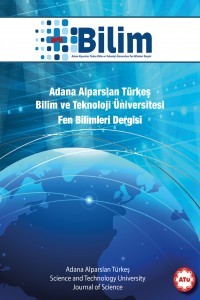Kümeleme tabanlı kablosuz algılayıcı ağların kara delik ve seçici yönlendirme saldırıları altında kayıp paket analizi
Günümüzde Kablosuz Algılayıcı Ağlar (KAA) sağlık izlemeden askeri takip sistemlerine kadar çeşitli alanlarda sıklıkla kullanılmaktadır. Düşük güç ve kolay kurulum avantajlarının yanında çözülmesi gereken kendisine özgü problemleri bulunmaktadır. Kablosuz iletim ortamının saldırıya açık doğası ve bu ağlardaki düğümlerin kaynak kısıtları KAA’da güvenlik problemleri için özel çözümlerin üretilmesine neden olmaktadır. Ağdan başarılı bir şekilde veri toplanmasını engelleyen ve kriptolojik yöntemlerle yakalanamayan iç saldırılar en tehlikeli saldırı gruplarındandır. Bu çalışmada yönlendirme katmanı iç saldırılarına dahil olan kara delik ve seçici yönlendirme saldırılarının farklı ağ alanları altında modellenmesi çalışması yapılmıştır. Simülasyonlar sonunda elde edilen sonuçlar kara delik saldırılarının %43’e, seçici yönlendirme saldırılarının ise %28’e varan oranda ortalama paket kayıplarına neden olduğu ve ağ alanı arttıkça yaşanan kayıpların daha da arttığını göstermektedir.
Anahtar Kelimeler:
Kablosuz algılayıcı ağlar, Performans değerlendirmesi, Yönlendirme atakları
Analysis of packet loss under black hole and selective forwarding attacks for cluster-based wireless sensor networks
Nowadays, Wireless Sensor Networks (WSNs) are widely used in various fields ranging from health monitoring to military monitoring systems. Besides the advantages of low power requirement and easy deployment, it has unique problems that have to be solved. The open nature of the wireless transmission environment and the resource constraints of the sensor nodes in WSNs results in special solutions for security problems. Insider attacks are the most dangerous types of attacks that prevent successful data collection from the network and can not be captured by traditional cryptographic methods. In this study, black hole and selective forwarding attacks, which are included in the routing layer internal attacks, is modelled and performed under different network sizes. The results obtained from the simulations show that average packet loss rates are up to 43% of black hole attacks and 28% of selective routing attacks, and that the loss rate increases as the network size increases.
___
- [1] Rawat, P., Singh, K. D., Chaouchi, H., & Bonnin, J. M. (2014). Wireless sensor networks: a survey on recent developments and potential synergies. The Journal of supercomputing, 68(1), 1-48.
- [2] Sharma, S., Bansal, R. K., & Bansal, S. (2013, December). Issues and challenges in wireless sensor networks. In Machine Intelligence and Research Advancement (ICMIRA), 2013 International Conference on (pp. 58-62). IEEE.
- [3] Jan, M. A. (2016). Energy-efficient routing and secure communication in wireless sensor networks (Doctoral dissertation).
- [4] Singh, S. K., Singh, M. P., & Singh, D. K. (2011). A survey on network security and attack defense mechanism for wireless sensor networks. International Journal of Computer Trends and Technology, 1(2), 9-17.
- [5] Sedjelmaci, H., Senouci, S. M., & Feham, M. (2012, July). Intrusion detection framework of cluster-based wireless sensor network. In Computers and Communications (ISCC), 2012 IEEE Symposium on (pp. 000857-000861). IEEE.
- [6] Singh, S. P., & Sharma, S. C. (2015). A survey on cluster based routing protocols in wireless sensor networks. Procedia computer science, 45, 687-695.
- [7] Tohma, K., Aydın, M. N., & Turgut, İ. A. (2015, May). Improving the LEACH protocol on wireless sensor network. In Signal Processing and Communications Applications Conference (SIU), 2015 23th (pp. 240-243). IEEE.
- [8] Heinzelman, W. R., Chandrakasan, A., & Balakrishnan, H. (2000, January). Energy-efficient communication protocol for wireless microsensor networks. In System sciences, 2000. Proceedings of the 33rd annual Hawaii international conference on (pp. 10-pp). IEEE.
- [9] Kalita, H. K., & Kar, A. (2009). Wireless sensor network security analysis. International Journal of Next-Generation Networks (IJNGN), 1(1), 1-10.
- [10] Roosta, T., Shieh, S., & Sastry, S. (2006, December). Taxonomy of security attacks in sensor networks and countermeasures. In The first IEEE international conference on system integration and reliability improvements (Vol. 25, p. 94).
- [11] Varga, A., & Hornig, R. (2008, March). An overview of the OMNeT++ simulation environment. In Proceedings of the 1st international conference on Simulation tools and techniques for communications, networks and systems & workshops (p. 60). ICST (Institute for Computer Sciences, Social-Informatics and Telecommunications Engineering).
- [12] Alippi, C., Anastasi, G., Di Francesco, M., & Roveri, M. (2009). Energy management in wireless sensor networks with energy-hungry sensors. IEEE Instrumentation & Measurement Magazine, 12(2).
- Yayın Aralığı: Yılda 2 Sayı
- Başlangıç: 2018
- Yayıncı: Adana Alparslan Türkeş Bilim ve Teknoloji Üniversitesi
Sayıdaki Diğer Makaleler
İpek ABASIKELEŞ TURGUT, Cansu CANBOLAT
Yüksek dayanımlı betonarme kolonların analizi için beton gerilme-birim deformasyon modeli
Şalgam suyunun üretim yöntemleri ve biyoaktif bileşenleri
Dilem TANRISEVEN, Sevgin DIBLAN, Serkan SELLİ, Haşim KELEBEK
Katı atık toplama sıklığının toplama-taşıma maliyetine etkisi
Mert KOLUKISAOĞLU, Kadriye Elif MAÇİN, İbrahim DEMİR
Düzensiz sipariş gelişlerinin risk analizi ve önceliklendirilmesi
